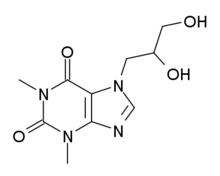Dyphylline
 | |
| Systematic (IUPAC) name | |
|---|---|
|
7-(2,3-dihydroxypropyl)-1,3-dimethyl-3,7-dihydro-1H-purine-2,6-dione | |
| Clinical data | |
| Trade names | Lufyllin |
| AHFS/Drugs.com | Consumer Drug Information |
| MedlinePlus | a682494 |
| Pregnancy category |
|
| Legal status |
|
| Identifiers | |
| CAS Number |
479-18-5 |
| ATC code | R03DA01 |
| PubChem | CID 3182 |
| IUPHAR/BPS | 7070 |
| DrugBank |
DB00651 |
| ChemSpider |
3070 |
| UNII |
263T0E9RR9 |
| KEGG |
D00691 |
| ChEBI |
CHEBI:4728 |
| ChEMBL |
CHEMBL1752 |
| Synonyms | 7-(2,3-dihydroxy-propyl)theophylline |
| Chemical data | |
| Formula | C10H14N4O4 |
| Molar mass | 254.24 g/mol |
| |
| |
| (verify) | |
Dyphylline (USAN) (trade names Dilor, Lufyllin), also known as diprophylline (INN), is a xanthine derivative with bronchodilator and vasodilator effects. It is used in the treatment of respiratory disorders like asthma, cardiac dyspnea, and bronchitis. It acts as an adenosine receptor antagonist and phosphodiesterase inhibitor.[1][2]
See also
References
- ↑ Schwabe U, Ukena D, Lohse MJ (September 1985). "Xanthine derivatives as antagonists at A1 and A2 adenosine receptors". Naunyn-Schmiedeberg's Archives of Pharmacology 330 (3): 212–21. doi:10.1007/bf00572436. PMID 2997628.
- ↑ Iancu L, Shneur A, Cohen H (1979). "Trials with xanthine derivatives in systemic treatment of psoriasis". Dermatologica 159 (1): 55–61. doi:10.1159/000250562. PMID 225216.
| ||||||||||||||||||||||||||||||||||||||||||||||||||||||||||||||||||
| ||||||||||||||||||||||||||||||||||||||||||||||||||
| ||||||||||||||||||||||||||||||||||||||||||||||
This article is issued from Wikipedia - version of the Sunday, June 28, 2015. The text is available under the Creative Commons Attribution/Share Alike but additional terms may apply for the media files.